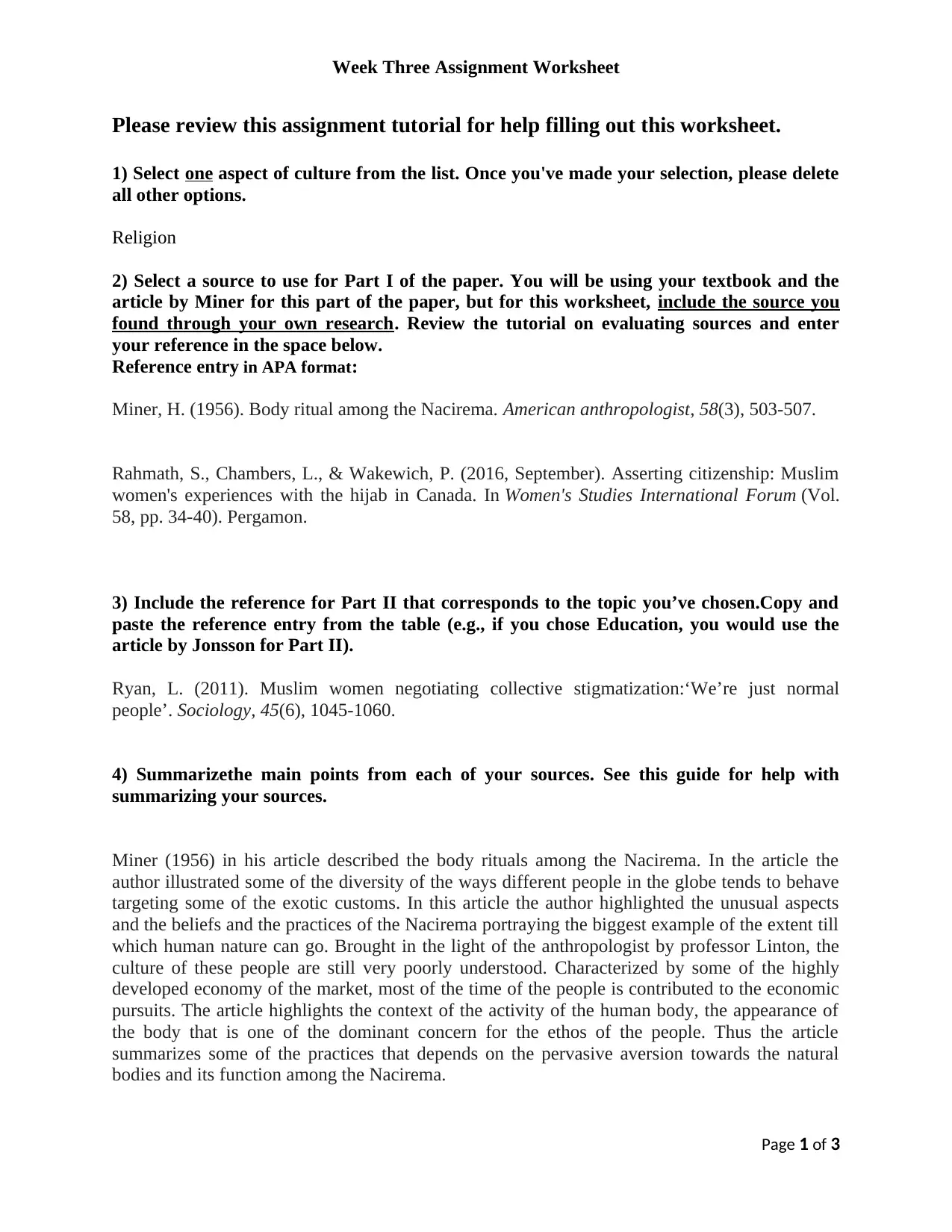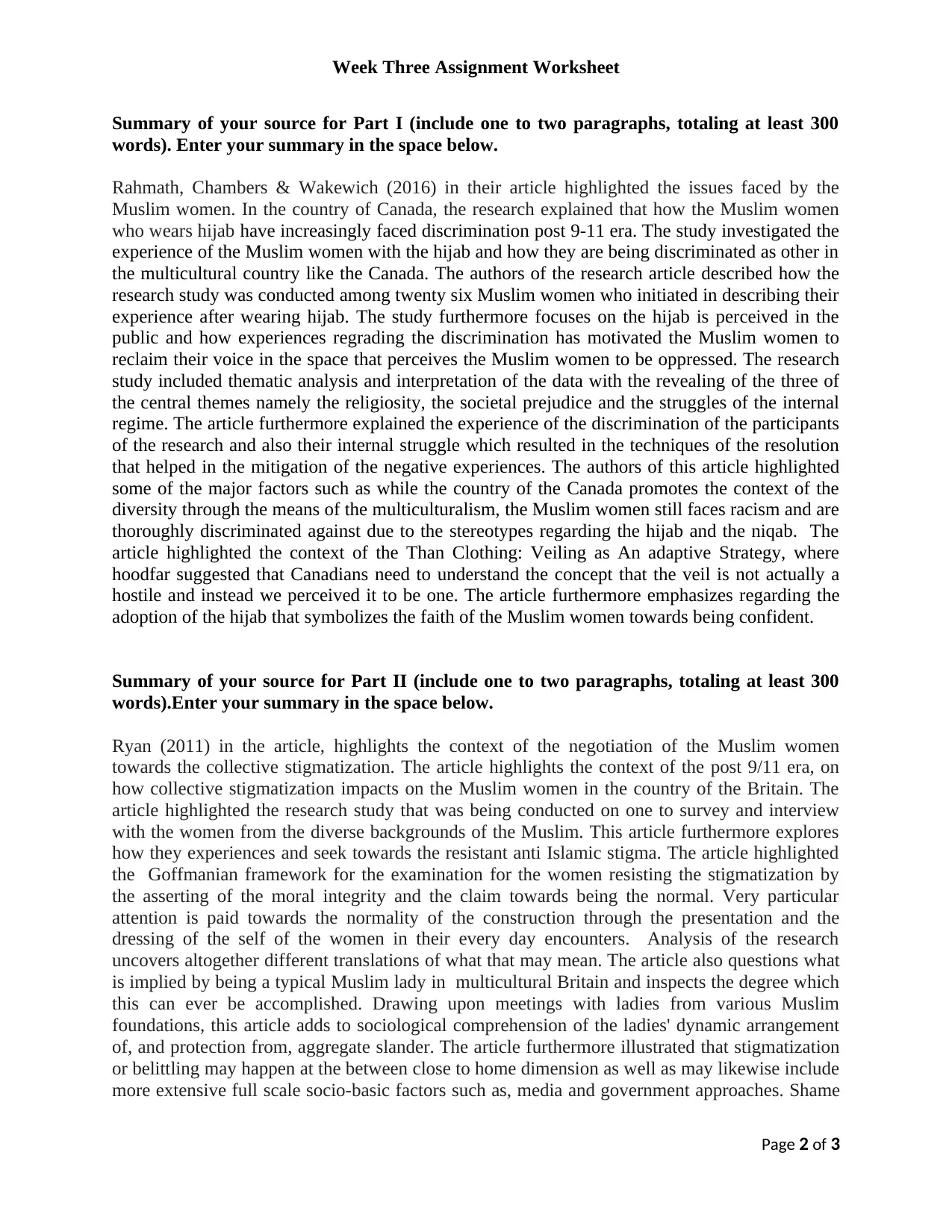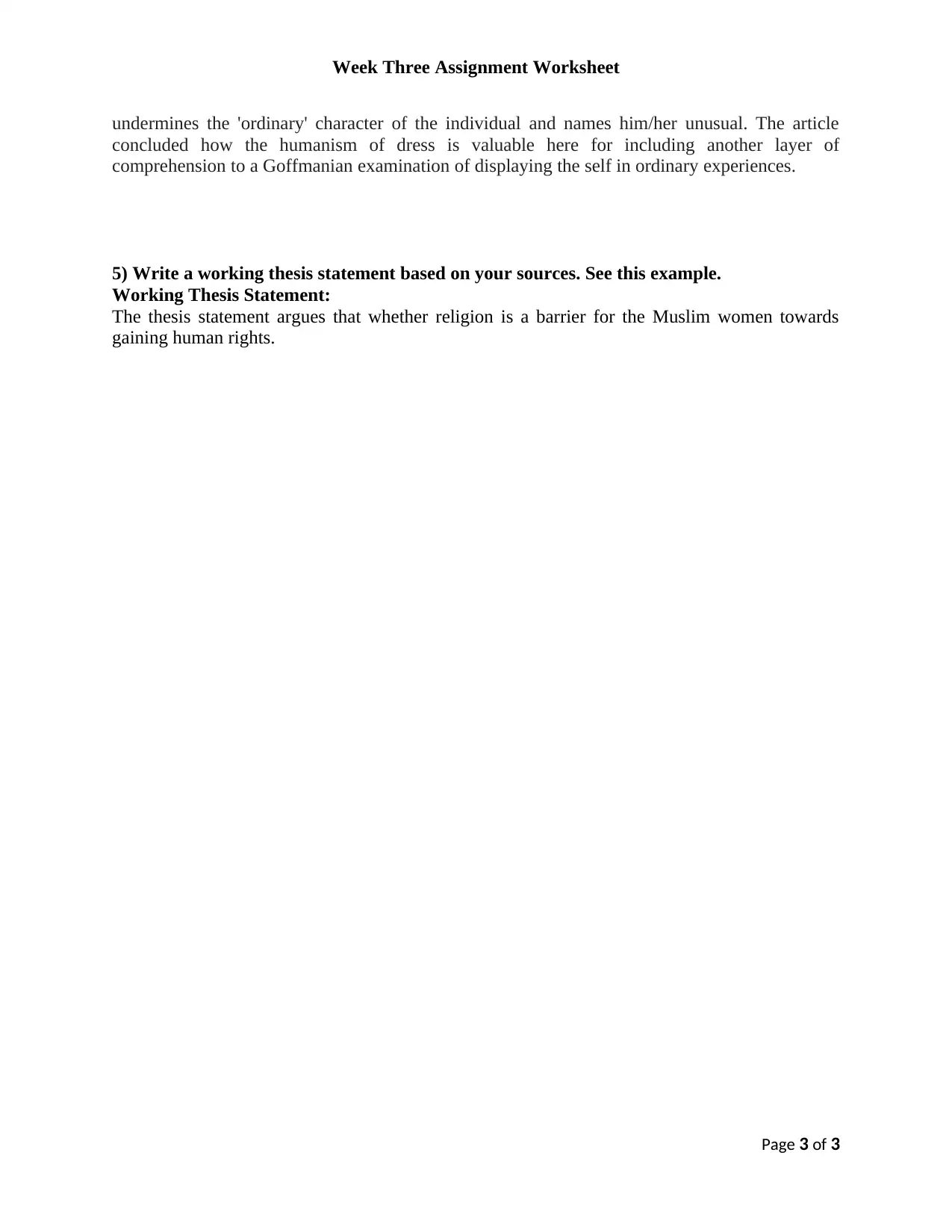Exploring Cultural Aspects: Body Rituals, Hijab Experiences, and Diversity
VerifiedAdded on 2023/04/25
|3
|1211
|372
Assignment
AI Summary
In this assignment we will discuss about cultural aspects and below are the summaries point:-
Miner's article (1956) discusses the body rituals among the Nacirema, showcasing unusual customs and beliefs of the people.
Rahmath, Chambers & Wakewich's article (2016) examines the experiences of Muslim women wearing hijab in Canada, highlighting discrimination and their efforts to assert their citizenship.
The articles shed light on cultural practices and the challenges faced by different groups, emphasizing the importance of understanding diverse cultures.
Contribute Materials
Your contribution can guide someone’s learning journey. Share your
documents today.

Week Three Assignment Worksheet
Please review this assignment tutorial for help filling out this worksheet.
1) Select one aspect of culture from the list. Once you've made your selection, please delete
all other options.
Religion
2) Select a source to use for Part I of the paper. You will be using your textbook and the
article by Miner for this part of the paper, but for this worksheet, include the source you
found through your own research. Review the tutorial on evaluating sources and enter
your reference in the space below.
Reference entry in APA format:
Miner, H. (1956). Body ritual among the Nacirema. American anthropologist, 58(3), 503-507.
Rahmath, S., Chambers, L., & Wakewich, P. (2016, September). Asserting citizenship: Muslim
women's experiences with the hijab in Canada. In Women's Studies International Forum (Vol.
58, pp. 34-40). Pergamon.
3) Include the reference for Part II that corresponds to the topic you’ve chosen.Copy and
paste the reference entry from the table (e.g., if you chose Education, you would use the
article by Jonsson for Part II).
Ryan, L. (2011). Muslim women negotiating collective stigmatization:‘We’re just normal
people’. Sociology, 45(6), 1045-1060.
4) Summarizethe main points from each of your sources. See this guide for help with
summarizing your sources.
Miner (1956) in his article described the body rituals among the Nacirema. In the article the
author illustrated some of the diversity of the ways different people in the globe tends to behave
targeting some of the exotic customs. In this article the author highlighted the unusual aspects
and the beliefs and the practices of the Nacirema portraying the biggest example of the extent till
which human nature can go. Brought in the light of the anthropologist by professor Linton, the
culture of these people are still very poorly understood. Characterized by some of the highly
developed economy of the market, most of the time of the people is contributed to the economic
pursuits. The article highlights the context of the activity of the human body, the appearance of
the body that is one of the dominant concern for the ethos of the people. Thus the article
summarizes some of the practices that depends on the pervasive aversion towards the natural
bodies and its function among the Nacirema.
Page 1 of 3
Please review this assignment tutorial for help filling out this worksheet.
1) Select one aspect of culture from the list. Once you've made your selection, please delete
all other options.
Religion
2) Select a source to use for Part I of the paper. You will be using your textbook and the
article by Miner for this part of the paper, but for this worksheet, include the source you
found through your own research. Review the tutorial on evaluating sources and enter
your reference in the space below.
Reference entry in APA format:
Miner, H. (1956). Body ritual among the Nacirema. American anthropologist, 58(3), 503-507.
Rahmath, S., Chambers, L., & Wakewich, P. (2016, September). Asserting citizenship: Muslim
women's experiences with the hijab in Canada. In Women's Studies International Forum (Vol.
58, pp. 34-40). Pergamon.
3) Include the reference for Part II that corresponds to the topic you’ve chosen.Copy and
paste the reference entry from the table (e.g., if you chose Education, you would use the
article by Jonsson for Part II).
Ryan, L. (2011). Muslim women negotiating collective stigmatization:‘We’re just normal
people’. Sociology, 45(6), 1045-1060.
4) Summarizethe main points from each of your sources. See this guide for help with
summarizing your sources.
Miner (1956) in his article described the body rituals among the Nacirema. In the article the
author illustrated some of the diversity of the ways different people in the globe tends to behave
targeting some of the exotic customs. In this article the author highlighted the unusual aspects
and the beliefs and the practices of the Nacirema portraying the biggest example of the extent till
which human nature can go. Brought in the light of the anthropologist by professor Linton, the
culture of these people are still very poorly understood. Characterized by some of the highly
developed economy of the market, most of the time of the people is contributed to the economic
pursuits. The article highlights the context of the activity of the human body, the appearance of
the body that is one of the dominant concern for the ethos of the people. Thus the article
summarizes some of the practices that depends on the pervasive aversion towards the natural
bodies and its function among the Nacirema.
Page 1 of 3
Secure Best Marks with AI Grader
Need help grading? Try our AI Grader for instant feedback on your assignments.

Week Three Assignment Worksheet
Summary of your source for Part I (include one to two paragraphs, totaling at least 300
words). Enter your summary in the space below.
Rahmath, Chambers & Wakewich (2016) in their article highlighted the issues faced by the
Muslim women. In the country of Canada, the research explained that how the Muslim women
who wears hijab have increasingly faced discrimination post 9-11 era. The study investigated the
experience of the Muslim women with the hijab and how they are being discriminated as other in
the multicultural country like the Canada. The authors of the research article described how the
research study was conducted among twenty six Muslim women who initiated in describing their
experience after wearing hijab. The study furthermore focuses on the hijab is perceived in the
public and how experiences regrading the discrimination has motivated the Muslim women to
reclaim their voice in the space that perceives the Muslim women to be oppressed. The research
study included thematic analysis and interpretation of the data with the revealing of the three of
the central themes namely the religiosity, the societal prejudice and the struggles of the internal
regime. The article furthermore explained the experience of the discrimination of the participants
of the research and also their internal struggle which resulted in the techniques of the resolution
that helped in the mitigation of the negative experiences. The authors of this article highlighted
some of the major factors such as while the country of the Canada promotes the context of the
diversity through the means of the multiculturalism, the Muslim women still faces racism and are
thoroughly discriminated against due to the stereotypes regarding the hijab and the niqab. The
article highlighted the context of the Than Clothing: Veiling as An adaptive Strategy, where
hoodfar suggested that Canadians need to understand the concept that the veil is not actually a
hostile and instead we perceived it to be one. The article furthermore emphasizes regarding the
adoption of the hijab that symbolizes the faith of the Muslim women towards being confident.
Summary of your source for Part II (include one to two paragraphs, totaling at least 300
words).Enter your summary in the space below.
Ryan (2011) in the article, highlights the context of the negotiation of the Muslim women
towards the collective stigmatization. The article highlights the context of the post 9/11 era, on
how collective stigmatization impacts on the Muslim women in the country of the Britain. The
article highlighted the research study that was being conducted on one to survey and interview
with the women from the diverse backgrounds of the Muslim. This article furthermore explores
how they experiences and seek towards the resistant anti Islamic stigma. The article highlighted
the Goffmanian framework for the examination for the women resisting the stigmatization by
the asserting of the moral integrity and the claim towards being the normal. Very particular
attention is paid towards the normality of the construction through the presentation and the
dressing of the self of the women in their every day encounters. Analysis of the research
uncovers altogether different translations of what that may mean. The article also questions what
is implied by being a typical Muslim lady in multicultural Britain and inspects the degree which
this can ever be accomplished. Drawing upon meetings with ladies from various Muslim
foundations, this article adds to sociological comprehension of the ladies' dynamic arrangement
of, and protection from, aggregate slander. The article furthermore illustrated that stigmatization
or belittling may happen at the between close to home dimension as well as may likewise include
more extensive full scale socio-basic factors such as, media and government approaches. Shame
Page 2 of 3
Summary of your source for Part I (include one to two paragraphs, totaling at least 300
words). Enter your summary in the space below.
Rahmath, Chambers & Wakewich (2016) in their article highlighted the issues faced by the
Muslim women. In the country of Canada, the research explained that how the Muslim women
who wears hijab have increasingly faced discrimination post 9-11 era. The study investigated the
experience of the Muslim women with the hijab and how they are being discriminated as other in
the multicultural country like the Canada. The authors of the research article described how the
research study was conducted among twenty six Muslim women who initiated in describing their
experience after wearing hijab. The study furthermore focuses on the hijab is perceived in the
public and how experiences regrading the discrimination has motivated the Muslim women to
reclaim their voice in the space that perceives the Muslim women to be oppressed. The research
study included thematic analysis and interpretation of the data with the revealing of the three of
the central themes namely the religiosity, the societal prejudice and the struggles of the internal
regime. The article furthermore explained the experience of the discrimination of the participants
of the research and also their internal struggle which resulted in the techniques of the resolution
that helped in the mitigation of the negative experiences. The authors of this article highlighted
some of the major factors such as while the country of the Canada promotes the context of the
diversity through the means of the multiculturalism, the Muslim women still faces racism and are
thoroughly discriminated against due to the stereotypes regarding the hijab and the niqab. The
article highlighted the context of the Than Clothing: Veiling as An adaptive Strategy, where
hoodfar suggested that Canadians need to understand the concept that the veil is not actually a
hostile and instead we perceived it to be one. The article furthermore emphasizes regarding the
adoption of the hijab that symbolizes the faith of the Muslim women towards being confident.
Summary of your source for Part II (include one to two paragraphs, totaling at least 300
words).Enter your summary in the space below.
Ryan (2011) in the article, highlights the context of the negotiation of the Muslim women
towards the collective stigmatization. The article highlights the context of the post 9/11 era, on
how collective stigmatization impacts on the Muslim women in the country of the Britain. The
article highlighted the research study that was being conducted on one to survey and interview
with the women from the diverse backgrounds of the Muslim. This article furthermore explores
how they experiences and seek towards the resistant anti Islamic stigma. The article highlighted
the Goffmanian framework for the examination for the women resisting the stigmatization by
the asserting of the moral integrity and the claim towards being the normal. Very particular
attention is paid towards the normality of the construction through the presentation and the
dressing of the self of the women in their every day encounters. Analysis of the research
uncovers altogether different translations of what that may mean. The article also questions what
is implied by being a typical Muslim lady in multicultural Britain and inspects the degree which
this can ever be accomplished. Drawing upon meetings with ladies from various Muslim
foundations, this article adds to sociological comprehension of the ladies' dynamic arrangement
of, and protection from, aggregate slander. The article furthermore illustrated that stigmatization
or belittling may happen at the between close to home dimension as well as may likewise include
more extensive full scale socio-basic factors such as, media and government approaches. Shame
Page 2 of 3

Week Three Assignment Worksheet
undermines the 'ordinary' character of the individual and names him/her unusual. The article
concluded how the humanism of dress is valuable here for including another layer of
comprehension to a Goffmanian examination of displaying the self in ordinary experiences.
5) Write a working thesis statement based on your sources. See this example.
Working Thesis Statement:
The thesis statement argues that whether religion is a barrier for the Muslim women towards
gaining human rights.
Page 3 of 3
undermines the 'ordinary' character of the individual and names him/her unusual. The article
concluded how the humanism of dress is valuable here for including another layer of
comprehension to a Goffmanian examination of displaying the self in ordinary experiences.
5) Write a working thesis statement based on your sources. See this example.
Working Thesis Statement:
The thesis statement argues that whether religion is a barrier for the Muslim women towards
gaining human rights.
Page 3 of 3
1 out of 3
Related Documents
Your All-in-One AI-Powered Toolkit for Academic Success.
+13062052269
info@desklib.com
Available 24*7 on WhatsApp / Email
![[object Object]](/_next/static/media/star-bottom.7253800d.svg)
Unlock your academic potential
© 2024 | Zucol Services PVT LTD | All rights reserved.
